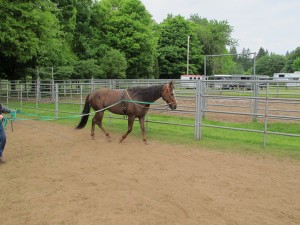After Friday’s excitement, I decided I needed to go out to the barn and ground drive Miss Mocha on Saturday. Part of my reasoning had to do with weather forecasts and plans, but the other part of it had to do with making sure that Reinstalling The Brain had taken.
Well, it had. We had a short conversation at the very beginning about not moving off until I gave her the direction to do so. She asserted herself a little bit, then settled in.
My other rationale for ground driving was to spend some time working with her body without bit, without saddle or rider, to get her shoulders loosened up and reestablish that good working rhythm she possesses when in good form. Ground driving is one of the most effective means I know of to pull off that kind of schooling. It gets rid of the rider and bit noise, gets rid of any saddle fit issues. It’s just you and the horse, and for once you can school the horse in fairly complex figures and see just what is going on. No, rollbacks and sliding stops can’t happen, and flying changes are a bit complex, but turning, bending, flexing, and two track can all happen using ground driving. Using a sidepull instead of a bit also counteracts the bit noise from the level of contact you need to maintain. I’ve wrapped the noseband in Vetwrap because otherwise the stitches in the leather (leather noseband only in sidepulls for me) can rub a little bit. The browband on this sidepull also tends to be a little snugger than I would like for Mocha. But here’s a pix of the setup I use:
Some people use a saddle pad under the surcingle. Right now I’m not too happy with my square English pad because it tends to slip on her (it was a real challenge riding with it in a horse show!) and I need to move the straps that hold it in place. My Western pad is way too bulky to use underneath. Plus, at some point I might want to go with a full harness and break her to pulling a cart, and I wouldn’t be putting a pad under that stuff, so….
Working in figures means that the horse also has to be thinking and paying attention to your verbal, whip and rein cues. To some extent (depending on how you’ve trained the horse), the whip can be used as a replacement for leg cues when you’re working close in and, for example, cueing a two track lateral movement. In that case you use a gentle tapping motion with the very tip of the whip to replicate a leg, spur or dressage whip cue. Of course, this assumes that the horse has been trained not to freak out at the sight or use of a whip, and a whip has been consistently used not just as a reprimand tool but as an extension of hand and leg, not just a “go forward” button. The handler needs to know the more sophisticated uses of a whip as cueing device, otherwise you might as well not be ground driving. The whip helps you straighten out the horse, especially in lateral work where the lack of leg and body cues may make things confusing for the horse at first.
We had confusion when I introduced a complex manuever–two tracking in a figure 8, wherein Mocha had to reverse the direction of the two track. Piece of cake under saddle where leg and seat provide the additional support and guidance to say “hey! Start moving laterally in this other direction!” But in ground driving, where the cues are rein, verbal and whip, it’s easy for the horse to get confused and struggle with the change. I had to hit my center point, give a verbal “walk on” cue, then ask for the opposite direction. After a couple of times doing that, the light switched on and we didn’t need to do more than a couple of steps of forward walk before she readily changed the direction of the two track. Under saddle, it would have been a simple matter of a weight shift. On the ground, well, a bit more, including a gentle whip tap. Mocha being Mocha, and always looking for a pattern to movement requests, it took only two repetitions and she had picked up on what I wanted.
At the end I got what I wanted…a much freer shoulder movement and steady, rhythmic gaits. I could have gotten that under saddle, but given that I also am wrestling with a shooting hip pain on one side, I’m just not always as effective in the saddle as I would like. Ground driving gave me the chance to do this work without the noise from rider impairment. A good thing.

